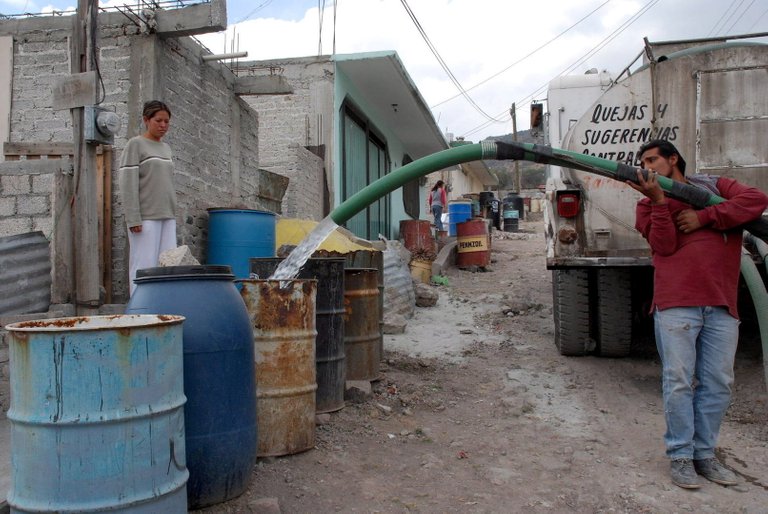
The lack of water for many of the 21 million inhabitants who reside in the Valley of Mexico , where the capital of the country and its surrounding populations are located, is nothing new. Currently, 20% of its residents receive just a few hours of water a day, a situation they share with another nine million Mexicans throughout the country. A study prepared by the National Water Commission, the World Bank and the National Association of Water Companies of Mexico ensures that, if the current model of consumption is not reversed, the Aztec capital will run out of drinking water reserves by the year 2030 .
A circumstance that it shares with 11 other cities in the world, including Cape Town , in South Africa, which is on track to become the first capital of the modern world next year without access to this precious asset. In fact, only the emergency measures and the moderation of its population have prevented this year the disaster predicted by the Government. To avoid this situation, which could also put a megalopolis like the Azteca on the verge of collapse, the Mexican authorities are already discussing possible solutions with experts .
The main causes that promise to dry the Mexican capital are: high consumption, contamination of its extraction sources and the poor state of its water transport system. Mexico, according to the Organization for Economic Cooperation and Development (OECD), suffers from water stress , that is, it consumes more water than nature can recharge.
32% of the supply in the Valley of Mexico comes from groundwater that has been overexploited: of the 625 extraction points that exist throughout the country, more than 100 are contaminated with arsenic . At present, the country's capital has 0% reserves in the capacity to regenerate aquifers, which also means that it has to import 40% of its water from distant sources. Many cities in the world that are in the same situation solve the problem by recycling wasted water, but, in the case of the Aztec capital, the poor condition of its pipes means that up to 40% of this reusable liquid is lost.
An inhabitant in Mexico City consumes an average of 366 liters per day , while the average in Spain is 132 liters. In Cape Town they had to limit their consumption to 25 liters to delay a few years more the arrival of the Day Zero, in which they waited for the running water to stop coming out of their faucets. At the national level, in Mexico, water is mainly used for agriculture and livestock, with 76.3%, followed by industry and energy generation, with 13%, and domestic use, with only 10%.
Faced with the evident water crisis that looms in one of the most populated and polluted cities on the planet, there are those who are already looking for efficient measures to recover a vital element for their survival. Among them are Renata Fenton and Enrique Lomnitz, some Mexican engineers who are already popularly known as "the water harvesters". Both are the founders of Isla Urbana, a rain catchment system that can be installed in any home or business.
They started their testing phase years ago in a neighborhood south of the capital, since that's where it rains most and where the largest number of homes that have no connection to the potable water network (250,000 people, approximately) are also concentrated.
According to the engineers during the presentation of the project: "In this place people do not have water in their houses, but when a storm falls, its streets become a river and all that water stagnates, causes floods and slowly returns to the system sewerage of the city without having been properly occupied. "

To date, Isla Urbana has managed to harvest more than 346 million liters of rainwater thanks to the installation of 8,000 devices that have directly benefited more than 50,000 people who previously did not have running water in their homes.
This group of engineers is one of the recipes that seek to solve the water shortage, although to a large extent, the rest of the actions go mainly through the hands of the capital government: to raise awareness , on the one hand, to the population to limit its consumption and, on the other hand, to adapt the pipes to the water needs of the city.
On October 31, some maintenance works of the Cuztmala System, from which a third of the water is extracted from the entire city, left about four million residents of the capital without water for 144 hours . In full celebrations for the Day of the Dead , when the city is usually filled with foreign tourists, a total of 13 city halls of the capital and 13 surrounding municipalities were affected and could only access water for two hours a day.
A good part of the population was made with water reserves to overcome a cut of historical proportions.
Schools, universities and nurseries suspended their classes for at least three days, the same situation that was experienced in many offices and businesses that also closed their doors. Other citizens chose to take advantage of the moment to go a few days of vacation and escape the chaos of a city without water.
These works served as a simulacrum to better understand how a large city could survive in the face of the shortage that will arrive , according to experts, from the year 2030.
In Latin America , which has 33% of the world's water resources, there are already 77 million people who do not have access to drinking water , while by 2025, more than 800 million people worldwide will not count with enough water if we do not start to change our consumption habits.